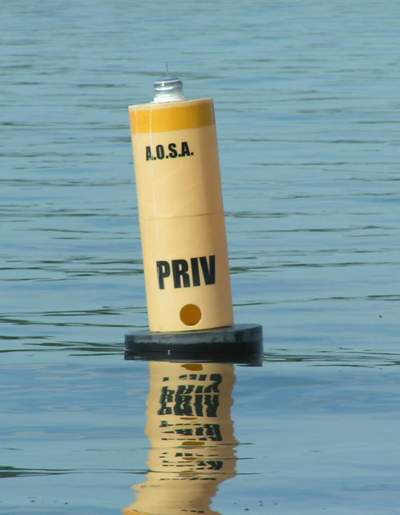
Alberta
Offshore Sailing Association
|
CARDINAL BUOY MAINTENANCE
|

| AOSA CARDINAL BUOYS | |||||
| LOCATION | INSTALLED | MOOR LINE | DEPTH | BOTTOM | CUSTODIAN |
| Coal Point | 2005, Spring |
- 20 feet of 3/8" line tied to 8' of 3/8" chain and a 20# navy anchor. |
10 to 15 ft | Sand. | Bob Schimmel |
| Sunshine Reed Bed | 2014, Spring | - 20' of steel line tied to a steel ring. | 10 ft | Mud. | Bob Schimmel |
|
CARDINAL BUOY MAINTENANCE. Setting or retrieving is best done using a stable Boston Whaler. SET BUOY - Stop the boat over the designated spot. Lower the anchor and roll the buoy over the side. Be careful you don't hit the strobe on top of the sail. Setting is best done using a stable Boston Whaler. RETRIEVE BUOY - Pull up along alongside a buoy and pull the mooring cable to the surface with a boat hook till the buoy is horizontal. With a gloved hand, grab the mooring line clevis and swing it over the gunwale. Pull the remainder of the buoy over the gunwale and tip it into the boat. Be careful you don't hit the strobe on top of the sail. COAL POINT - The mooring line consists of 20' of
3/8" yacht braid, 8' of 1/4" chain and a 20# navy anchor. WINTER STORAGE - Each buoy MUST be stored upright to protect the float to sail joint. There is a wood stand to facilitate this. If it lays down the weight of the sail will eventually tear itself off the float. LANTERN - Each Fall the lanterns
should be removed
from the buoys (use a Phillips screw driver and a 3/8" open ended
wrench to remove the
4 screws that fasten it to the sail), and place in a cardboard box to
exclude all light. Failing that, cover them from the sun. The computer measures the hours of darkness and if it exceeds 8
hours, the system shuts down to save the battery. |
|||||